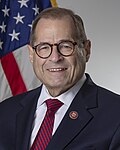
Interactive map version
The U.S. state of New York contains 26 congressional districts. Each district elects one member of the United States House of Representatives to represent it. [1]
Contents
- Current districts and representatives
- 2024 redistricting
- Obsolete districts
- Historical district maps
- See also
- References
- External links
The state was redistricted in 2022, following the 2020 U.S. census. It lost one seat in Congress. [2] According to CNN, unnamed census officials stated that if 89 more people had been counted in New York's census results, and all other states' population figures had remained the same, New York would not have lost a congressional seat. [3]





















































